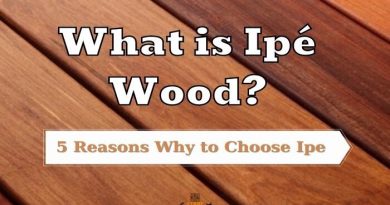Is Wood a Conductor or an Insulator? (Quick Answer)
To dive into the subject we will ask ourselves the following question : Is Wood a Conductor or Is Wood an Insulator?
But to answer this question, first it is necessary to be clear about some terms, one of these is electricity or also called electric current , we will define it as the flow of electric charge that circulates through a material, this flow of electric charge is basically a quantity of electrons that move or “flow” through a material that does not impede their passage.
The wood is one of the materials most widely used in various fields because of the infinite number of properties that it holds. One of the most striking and intriguing properties that wood possesses is its electrical properties . Believe it or not, this material has even been used as a conductor of electricity.
What exactly is an electrical conductor?
An electrical conductor is a body which allows electric current to pass and which is therefore opposed to electrical insulators. Metals are, for example, conductors of electricity.
By electrical conductor we mean a material capable of making electrical energy flow through it by means of free electrons or ionic species with positive and negative charge capable of carrying current.
Materials that do not prevent the passage of electrons by letting them flow through are called conductors . The quality that makes a material conductive (this is the other term that we will need to understand) is the presence of free electrons, the greater their presence in the matter that composes it, the greater the conductivity and vice versa.
Conductors and insulators: how they work
The conductive materials are distinguished by their ability to conduct electrical current, which differentiates them from those insulators that, on the contrary, hinder the passage of electrical current.
The first category includes metals ( copper, silver, iron, lead and zinc ), to which a specific electrical voltage is applied that generates a passage of current thanks to the fact that the atoms present inside them, not being closely linked to the nucleus of the atoms, they can move freely.
The second category, that of insulators , includes materials such as plastic, glass, rubber and wood , in which the electrons, bound to the atoms, do not move and therefore do not allow the electrical charges to be released.
Is Wood a Conductor?
Wood belongs to the category of dielectrics, in the normal state, wood does not conduct electric current. Wet wood can conduct electricity although in this case, the conductor of the electric current will be the water molecules in the wood, and not the wood itself.
Electrical current is defined as a free flow of electricity and metals are very good conductors as they easily pass electrical current. On the other hand there are materials that do not allow electrical current to flow easily and they are called insulators.
Majority of non-metallic materials such as dry wood, plastic, and rubber are insulators.
Wood does not conduct electricity when it is very dry and is therefore wood is considered an insulator. On the other hand, a small amount of current can flow in wet wood. And if the water itself is not conductive in its pure state, it becomes so when it is filled with impurities, minerals (such as tap water, spring water and mineral water) or when it is salty.
Also when heated the wood becomes charcoal which contains a lot of carbon (a natural element that is also very conductive) and acts like an electrical conductor. It is far from the best electrical conductor but still a conductor.
Is Wood an Insulator?
Insulators are materials where electrons cannot circulate freely, such as ceramics, glass, plastics in general, paper, wood , etc. These materials do not conduct electrical current.
Wood does not conduct electricity when it is very dry and is therefore considered an insulator as it is a poor conductor of heat and electricity. Unlike metals where electrons are loosely bound to individual atoms, wood has a mix of molecules where electrons are tightly bound and not free to move from one molecule to another.
It is for this reason that wood is taken as an insulator, because it is not good at conducting electricity and heat, and although this material is generally taken as a dielectric there are a variety of types of wood that can insulate electricity to a greater or lesser extent. This will depend on the density of the wood and the moisture contained in it.
Dry wood is almost a dielectric( practically does not conduct current). Once upon a time, boards for electrical circuits were even made from dry oak.
In this article you will learn the best methods to dry wood in a microwave!
And the body of radio and television sets made of wood or plywood is still remembered by many people. And on the posters on security measures, there was always a picture of a man removing a bare electrical wire from a shock-struck wooden rail.
It is also true that there are voltages so high that they cannot be isolated by the wood and there is nothing left to do but “transfer” it, so to speak, this voltage damages the material by burning it.
On the other hand, wood is a poor conductor of heat, because the mixture of long chain molecules is very inefficient in transferring energy quickly. Unlike metal, wood does not have the “sea of electrons” that can transfer heat quickly across the surface.
Type of Electrical Insulators and Conductors
| Electrical Insulators | Electrical Conductors |
|---|---|
| 1. Dry wood | 1. Copper |
| 2. Plastic | 2. Gold |
| 3. Glass | 3. Silver |
| 4. Rubber | 4. Iron |
| 5. Paper | 5. Aluminum |
| 6. Porcelain | 6. Salted water |
| 7. Cardboard | 7. Non-distilled water |
| 8. Air | 8. Zinc |
| 9. Oil | 9. Nickel |
| 10. Cellulose | 10. Graphite |
| 11. Mica | 11. Platinum |
| 12. Teflon | 12. Stainless steel |
| 13. Cork | 13. Brass |
| 14. Ceramics | 14. Graphite |
| 15. Aluminum oxide | 15. Carbon Steel |
| 16. Expanded clay | 16. Bronze |
| 17. Mylar | 17. Lithium |
Why is wood a good insulator?
The high moisture content present in the woody material makes it a good insulator, therefore the more it increases the more the electrical resistance will decrease.
The moisture in the wood has a decisive influence on the conductivity of the wood. If the moisture in the wood increases, the electrical resistance decreases and water conducts the electrical charges better.
Reasons why wood is a good insulator:
- Wood works well as an insulator because there is a void(vacuum) in it. Vacuum is an insulating medium that does not conduct electric current, so it can serve as an insulator.
- There are no free electrons in a wood through which electricity passes. Hence, it has high resistance. The atoms present in wood do not transfer heat to their neighboring atoms. There is no heat conduction, convection or radiation to provide heat flow. Hence, wood is an insulator.
- Density, wood structure, wood species. Due to the different density and the different substances contained in the wood, the belonging to a specific wood species strongly influences the resistance and electrical conductivity of the wood.
- Wood is a good electrical insulator because electricity is purely the transfer of energy due to the movement of electrons, and wood may contain a certain amount of conduction electrons to conduct, but it can be either very small or before conduction electrons can be delivered.
Can electricity pass through wood?
It is a myth that wood does not conduct current or electricity. In fact, wood is non-conductive, but water conducts electricity. If the wood is wet or damp, it still presents a risk. Wood can be made into a very good low voltage conductor. Also high voltage power can easily pass through wood
Is wet wood a good conductor of electricity?
Small amounts of electrons(current) can pass through wet wood because water is conductive but it is not useful as an electrical conductor because its resistance is very high.
Electrical properties of wood
The most important electrical properties of wood are conductivity, electrical constant, and dielectric power factor. These three electrical properties measure and determine how wood reacts when exposed to electrical currents and how it is affected by this.
1.Electrical conductivity.
The ability of wood to conduct electric current is inversely related to its electrical resistance.
The greatest value for the characteristics of the electrical conductivity of the material is the first type of resistance, the indicator of which is the specific volumetric resistance having the dimension of Ohm cm and numerically equal to the resistance when the current passes through two opposite sides of the cube measuring 1x1x1 cm of the published material (wood).
Wood belongs to dielectrics (10 8 -10 17 Ohm · cm). Methods for measuring the resistance of solid dielectrics at constant voltages are applicable to it.
In the case of wood, the electrical conductivity varies slightly with the application of voltage to it and doubles when the temperature of the wood exceeds 10 ° C (18 ° F). However, the moisture content is a factor that greatly affects the electrical conductivity of wood : as the moisture content increases, the electrical conductivity will increase significantly.
Conductivity in wood is higher along the grain than across the grain, and slightly better in the radial direction than in the tangential direction.
When wood contains abnormal amounts of salt in soluble water or any other substance with electrolytes, such as preservatives or fire retardant treatments, or is in constant contact with seawater, the electrical conductivity can increase substantially.
When the moisture content is less than 8%, the increase is slow.
2.Electrical strength
This is the name of the ability of wood to resist breakdown, that is, to reduce resistance at high voltages. To determine the electrical strength of wood at an alternating voltage with a frequency of 50 Hz. The indicator of the electric strength is the ratio of the breakdown voltage to the thickness of the material, kV / mm.
The electrical strength of absolutely dry wood along the grain is 1.3-1.5 kV / mm, which is 4-7 times less than across the grain. With increasing humidity, the dielectric strength decreases markedly. The strength decreases by 2 times when the humidity changes from 10 to 14%.
The electrical strength of wood in comparison with other solid insulating materials is low (for glass E pr = 30, for polyethylene – 40 kV / mm). To increase the electrical strength, wood is impregnated with paraffin, drying oil, artificial resins and other substances.
3. Dielectric power factor
The dielectric power factor of a non-conductive material determines the fraction of stored energy that is dissipated as heat. When a non-conductive material like wood is in an electric field, it absorbs and stores potential energy.
The dielectric power factor in wood is considered large, compared to that of inert plastic insulating materials. However, there are other materials, such as some forms of rubber, that have dielectric power factors as high as those of wood .
The dielectric power factor of wood varies between 0.01, for dry wood, and 0.95 for wood with large amounts of moisture. This electrical property of wood is usually greater for electric fields along the grain than across the grain, although this is not always the case.
Throughout the article, we have talked about the electrical properties of wood , their definitions and how they affect this material when it is subjected to electric fields or environments with electric currents. Now that you know all this, you must ask yourself what level of humidity is suitable for the interaction of electrical properties to be adequate.
Well, here we have two top 5 that will be of great help. The first top 5 is one of the woods with the best conductivity. For hardwoods they are:
- White ash
- Raft
- Red maple
- Red oak
- Black cherry
For soft woods they are:
- Pine tree
- Cedar
- Fir tree
- Hemlock
- Spruce
The second top 5 is about moisture content percentages and how the electrical properties of wood react to these moisture levels. These results have been obtained when exposing various types of wood to electric currents, for which they are considered general data.
When the moisture content of the wood is 26%, the electrical resistance can reach a range of -1.
As the moisture content decreases, the electrical resistance begins to vary; in this way: at 18% the resistance is 0. At 14%, the resistance is 1.
At 10% the resistance is significantly increased to 3. Between 8% and 6% moisture content, the electrical resistance reaches 6.
Conclusion
Wood when dry does not conduct electricity and therefore wood is an insulator. However, when wet, it turns out to be a conductive material, which makes it dangerous in the presence of an electric current.




